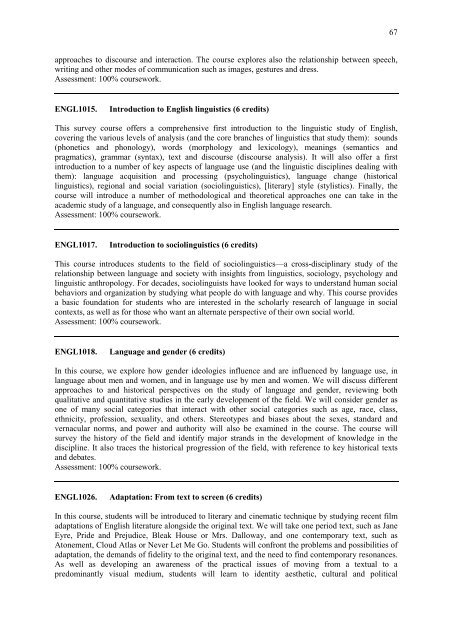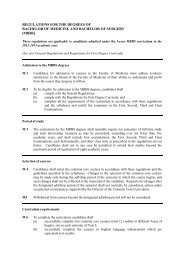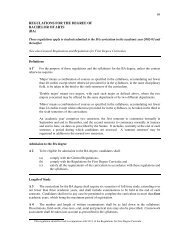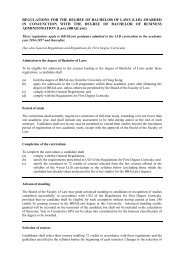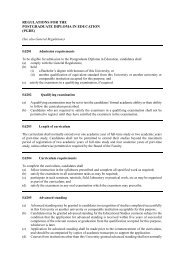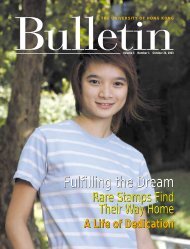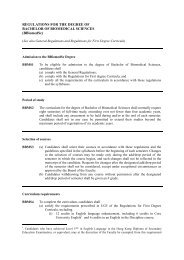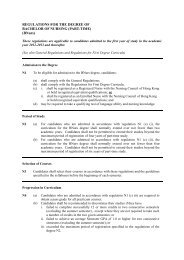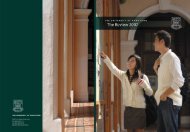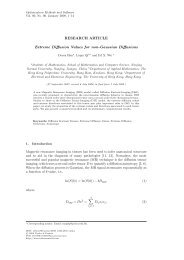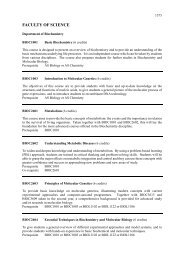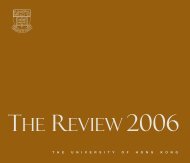(BA) (4-year-programme) - The University of Hong Kong
(BA) (4-year-programme) - The University of Hong Kong
(BA) (4-year-programme) - The University of Hong Kong
You also want an ePaper? Increase the reach of your titles
YUMPU automatically turns print PDFs into web optimized ePapers that Google loves.
67approaches to discourse and interaction. <strong>The</strong> course explores also the relationship between speech,writing and other modes <strong>of</strong> communication such as images, gestures and dress.Assessment: 100% coursework.ENGL1015.Introduction to English linguistics (6 credits)This survey course <strong>of</strong>fers a comprehensive first introduction to the linguistic study <strong>of</strong> English,covering the various levels <strong>of</strong> analysis (and the core branches <strong>of</strong> linguistics that study them): sounds(phonetics and phonology), words (morphology and lexicology), meanings (semantics andpragmatics), grammar (syntax), text and discourse (discourse analysis). It will also <strong>of</strong>fer a firstintroduction to a number <strong>of</strong> key aspects <strong>of</strong> language use (and the linguistic disciplines dealing withthem): language acquisition and processing (psycholinguistics), language change (historicallinguistics), regional and social variation (sociolinguistics), [literary] style (stylistics). Finally, thecourse will introduce a number <strong>of</strong> methodological and theoretical approaches one can take in theacademic study <strong>of</strong> a language, and consequently also in English language research.Assessment: 100% coursework.ENGL1017.Introduction to sociolinguistics (6 credits)This course introduces students to the field <strong>of</strong> sociolinguistics—a cross-disciplinary study <strong>of</strong> therelationship between language and society with insights from linguistics, sociology, psychology andlinguistic anthropology. For decades, sociolinguists have looked for ways to understand human socialbehaviors and organization by studying what people do with language and why. This course providesa basic foundation for students who are interested in the scholarly research <strong>of</strong> language in socialcontexts, as well as for those who want an alternate perspective <strong>of</strong> their own social world.Assessment: 100% coursework.ENGL1018.Language and gender (6 credits)In this course, we explore how gender ideologies influence and are influenced by language use, inlanguage about men and women, and in language use by men and women. We will discuss differentapproaches to and historical perspectives on the study <strong>of</strong> language and gender, reviewing bothqualitative and quantitative studies in the early development <strong>of</strong> the field. We will consider gender asone <strong>of</strong> many social categories that interact with other social categories such as age, race, class,ethnicity, pr<strong>of</strong>ession, sexuality, and others. Stereotypes and biases about the sexes, standard andvernacular norms, and power and authority will also be examined in the course. <strong>The</strong> course willsurvey the history <strong>of</strong> the field and identify major strands in the development <strong>of</strong> knowledge in thediscipline. It also traces the historical progression <strong>of</strong> the field, with reference to key historical textsand debates.Assessment: 100% coursework.ENGL1026.Adaptation: From text to screen (6 credits)In this course, students will be introduced to literary and cinematic technique by studying recent filmadaptations <strong>of</strong> English literature alongside the original text. We will take one period text, such as JaneEyre, Pride and Prejudice, Bleak House or Mrs. Dalloway, and one contemporary text, such asAtonement, Cloud Atlas or Never Let Me Go. Students will confront the problems and possibilities <strong>of</strong>adaptation, the demands <strong>of</strong> fidelity to the original text, and the need to find contemporary resonances.As well as developing an awareness <strong>of</strong> the practical issues <strong>of</strong> moving from a textual to apredominantly visual medium, students will learn to identity aesthetic, cultural and political


